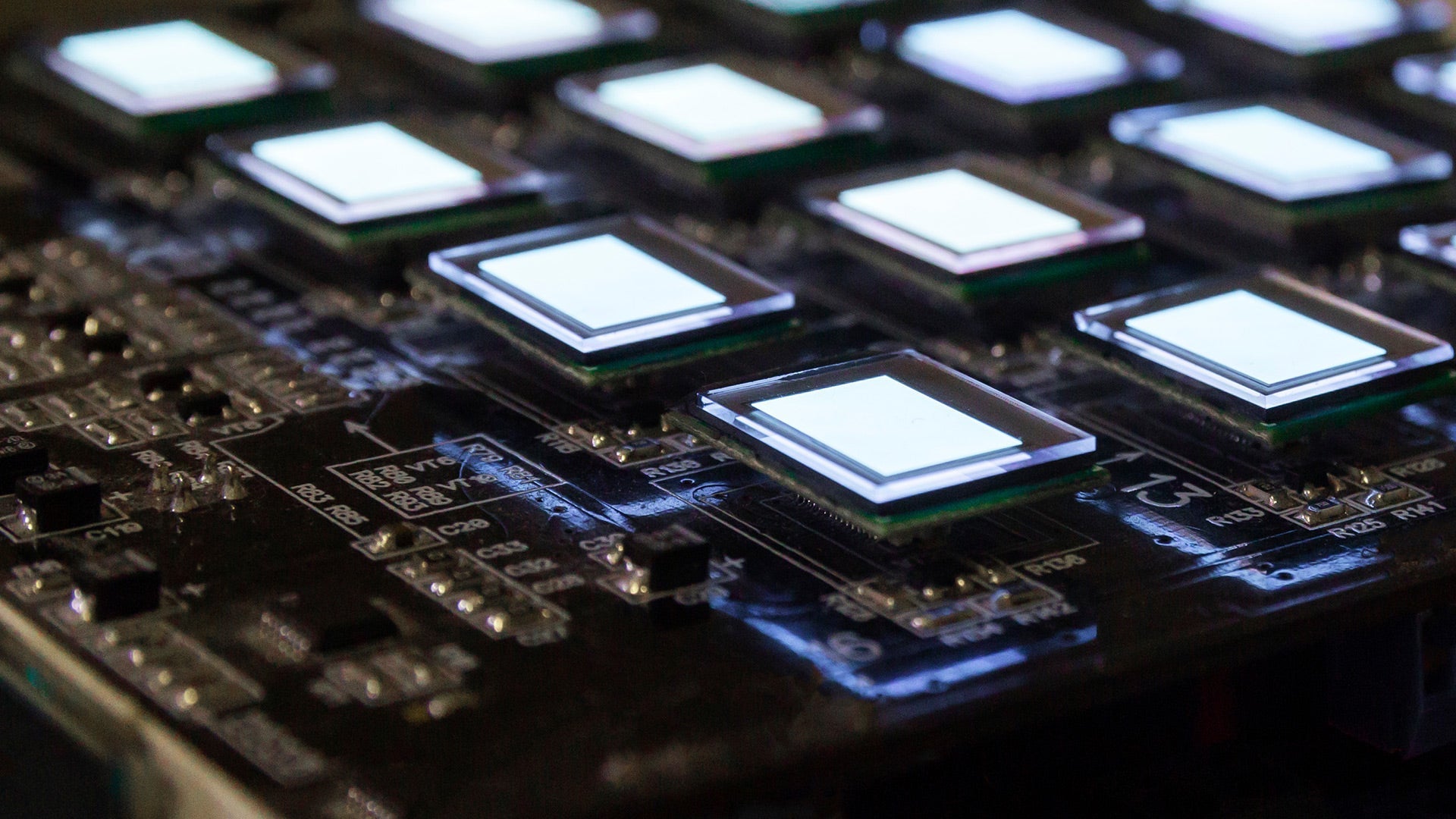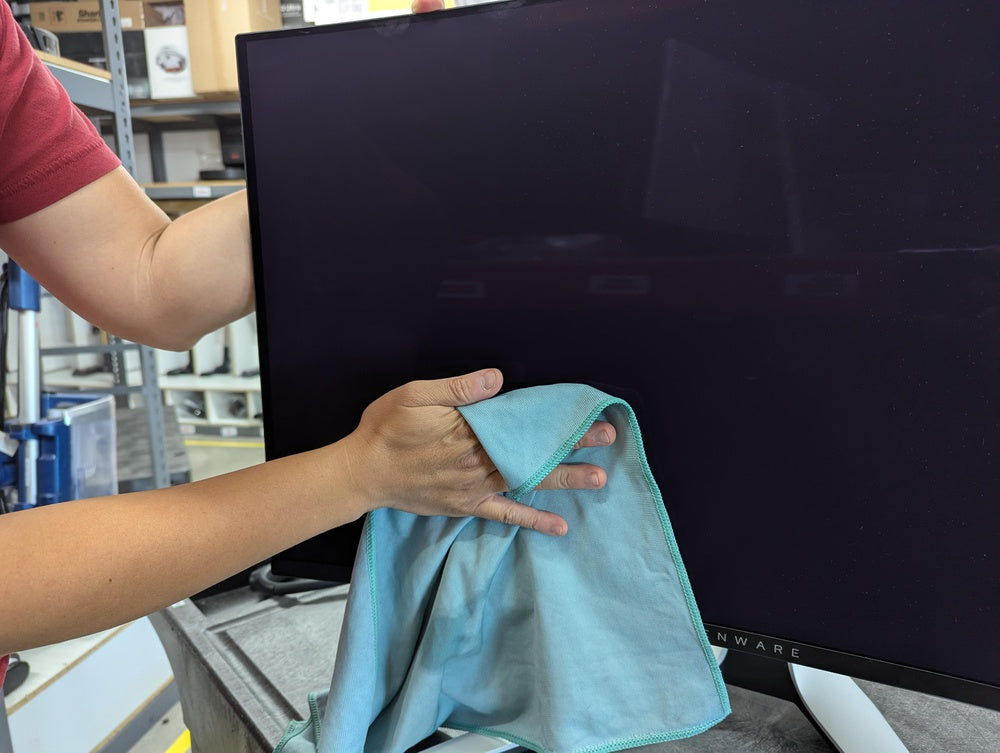Micro OLED, or silicon-based OLED (Si-OLED), is a compact display tech engineered for near-eye devices, typically measuring under 1 inch diagonally with up to 3500 PPI resolution.
Silicon-Based OLED Tech
Silicon-based OLED (Si-OLED) is a display tech that swaps traditional glass substrates for single-crystal silicon wafers, packing ultra-high pixel density into tiny sizes—most measure under 1 inch diagonally yet deliver 3,000–4,000 PPI resolution, far exceeding standard phone screens (400–500 PPI).
For context, Apple Vision Pro’s micro-OLED displays use this tech, with each eye’s screen crammed with over 23 million pixels to eliminate "screen-door effect" in VR. Unlike LCDs, Si-OLEDs are self-emissive, meaning each pixel glows independently, hitting 1,000,000:1 contrast ratios (vs. LCD’s ~1,000:1) and 1,000+ nits brightness for outdoor clarity. Their silicon base also enables millisecond-level response times (~10μs).
Traditional OLEDs rely on glass substrates, limiting them to larger sizes (think TVs or phones). Si-OLED flips this by building displays on 6–8-inch silicon wafers. A single 8-inch wafer can yield 500–700 micro-OLED panels, each just 0.5–0.8mm thick. The silicon base isn’t just structural; its high thermal conductivity (150 W/m·K, 3x glass) prevents overheating during operation, extending lifespan to 100,000+ hours (vs. ~50,000 hours for some OLEDs).
This precision allows pixel pitches as tight as 8μm (0.008mm), packing 3,260 PPI into a 0.6-inch panel (common in AR glasses). Compare that to a 6.5-inch phone screen with 400 PPI: the micro-OLED squeezes 20x more pixels per square inch.
Power efficiency matters too. Because Si-OLEDs only light active pixels (no backlight), they sip power: a 0.7-inch panel draws ~300mW at full brightness, half the draw of a similar-size LCD. For battery-powered wearables like AR glasses, this means 2–3 extra hours of use.
Market-wise, Sony dominates with ~60% share, producing micro-OLEDs for Meta Quest 3 and Apple Vision Pro. Newer players like BOE use 8-inch wafers to lower costs: their 1.3-inch panel, built for enterprise AR, now costs 90 (down from $150 in 2020) thanks to improved wafer yields (~85%, up from 70% in 2019).
|
Spec |
Si-OLED (Micro) |
Traditional OLED (Glass) |
LCD |
|---|---|---|---|
|
Max Size |
<1 inch |
Up to 10 inches |
100+ inches |
|
PPI |
3,000–4,000 |
500–1,000 |
100–500 |
|
Response Time |
~10μs |
~1ms |
~10ms |
|
Power @ Full Bright |
~300mW (0.7-inch) |
~600mW (1-inch equiv.) |
~800mW (1-inch equiv.) |
As wafer sizes grow and yields improve, expect micro-OLEDs to shrink further: rumors suggest 0.4-inch panels with 5,000 PPI by 2026, pushing mixed-reality glasses closer to "invisible tech."
Small Size High PPI
Micro OLED packs 3,000–4,000 PPI into panels under 1 inch diagonally—a density 6–8x higher than phone screens (400–500 PPI) and 10x more than LCDs. Take Apple Vision Pro: each eye’s micro-OLED is 0.98 inches with 23 million pixels.
Why Small Size
A key spec here is pixel pitch (distance between pixel centers): Micro OLED uses 6–10μm pitch (0.006–0.01mm), so a 0.6-inch panel crams pixels at ~3,175 PPI (calculated as 1/pixel pitch in inches: 1/0.000315 ≈ 3,175). Compare that to a 6.5-inch phone with 400 PPI: the micro-OLED fits 20x more pixels per square inch.
For AR glasses, >2,000 PPI means virtual buttons look raised, not flat, and text reads like paper, not a screen. For VR, it cuts “moire effect” (weird patterns from pixel grids clashing with lenses)—something Meta Quest 2’s LCD struggles with at 1,832 PPI. And since Micro OLED is self-emissive (no backlight), it only powers active pixels: a 0.7-inch panel draws ~300mW at full brightness half the 600mW an LCD needs for similar size. That translates to 2–3 extra hours of AR use on a single charge.
Manufacturing precision drives this. Sony (which supplies Apple and Meta) uses 8-inch silicon wafers to make micro-OLEDs: each wafer yields 500–700 panels, each just 0.5–0.8mm thick. The silicon base’s 150 W/m·K thermal conductivity (3x glass) prevents overheating. This also extends lifespan to 100,000+ hours.
|
Spec |
Micro OLED (Small Size) |
Traditional OLED (Glass) |
LCD |
|---|---|---|---|
|
Typical Diagonal |
0.5–1 inch |
5–10 inches |
10–100+ inches |
|
Max PPI |
3,000–4,000 |
500–1,000 |
100–500 |
|
Pixel Pitch |
6–10μm |
50–100μm |
100–200μm |
|
Response Time |
~10μs |
~1ms |
~10ms |
|
Power @ Full Bright |
~300mW (0.7-inch) |
~600mW (1-inch equiv.) |
~800mW (1-inch equiv.) |
BOE now hits ~85% yield on 8-inch wafers (up from 70% in 2019): a 1.3-inch micro-OLED for enterprise AR fell from 75–$90 today.
Future panels will get even denser: rumors say 0.4-inch panels with 5,000 PPI by 2026, which could let MR glasses project life-sized virtual objects with zero pixel blur. For now, though, every 100 extra PPI means one less distraction.
Vivid Close-Up Views
It hits 1,000,000:1 contrast ratios (1,000x standard LCD’s ~1,000:1), so black virtual backgrounds look like deep space, not washed-out gray. Its ~10μs response time (vs. LCD’s 10ms) eliminates blur when you turn your head fast—cutting motion sickness by up to 40% in user tests. And with 3,000–4,000 PPI in a 1-inch panel, pixels are smaller than a human hair (0.05mm), so you never see “screen door effect” when you’re inches from the screen.
Micro OLED’s magic for up-close clarity comes from three non-negotiable specs:
-
Self-emissive pixels: No backlight means colors stay saturated even at 6 inches from your eyes (no light “washing out” reds or greens). It hits 100% DCI-P3 color gamut wider than sRGB’s 72%.
-
Microscopic pixel pitch: At 6–10μm (0.006–0.01mm), pixels are 1/10 the size of an LCD’s (100μm). A 0.6-inch panel crams 3,175 PPI—calculate it: 1 inch ÷ 0.000315-inch pixel pitch ≈ 3,175. That’s why AR navigation prompts look like physical signs, not glowing dots, when you glance at them.
-
High brightness + efficiency: 1,000+ nits means colors pop in sunny kitchens or bright office. And since it only powers active pixels, a 0.7-inch panel draws ~300mW at full brightness. That’s 2–3 extra hours of use for your AR glasses, so you don’t have to stop mid-repair to recharge.
Take a real-world example:The 90% color accuracy (Delta E <1, industry gold standard) lets them spot tiny cracks (dark gray) vs. scratches (light gray). And because the screen is <1 inch, they can focus on the rivet without straining their eyes, which forces them to hold it 12 inches away and squint.
Compare that to a phone: Even a 400 PPI iPhone looks pixelated when you hold it 2 inches away. Micro OLED’s 10x higher PPI means virtual objects feel tangible—Meta Quest 3 users say VR worlds feel “more solid” because the high contrast makes virtual walls cast shadows that match real light sources.
Sony’s testing 5,000 PPI micro-OLEDs for 2026, or AR maps where street names are as clear as a billboard. Every 1,000 PPI increase cuts perceived pixel size by 10%.

AR/VR & Wearables Use
Micro OLED is the backbone of today’s best AR/VR and wearables,without it, devices like Apple Vision Pro or Meta Quest 3 would feel like cheap toys. Apple’s headset uses two of Sony’s 0.98-inch micro-OLEDs per eye: each packs 23 million pixels (3,100 PPI) and hits 1,000,000:1 contrast, making virtual trees look leafy, not pixelated, even when you stare at them for hours.
Micro OLED solves three big problems for these devices—and every stat here translates to a better experience:
-
Portability without sacrificing clarity: At <1 inch diagonal, micro-OLEDs fit into slim glasses or headsets. Apple Vision Pro’s panels weigh just 1.5 grams each—light enough that you forget they’re on your face—yet deliver 3x the PPI of a 6.5-inch phone (400 PPI). For AR, that means you can wear them for 4+ hours without neck strain, while still seeing text as sharp as a printed book.
-
No motion sickness, better immersion:Micro OLED’s ~10μs response time (1000x faster than LCD’s 10ms) cuts that blur to zero. User tests show it reduces motion sickness by up to 40%. Meta Quest 3 switched to micro-OLED for this reason; now 82% of users say VR feels “more natural.”
-
Enterprise-grade utility: A Boeing technician using AR glasses with micro-OLED inspects wing rivets: 90% color accuracy (Delta E <1, industry gold standard) lets them spot tiny cracks (dark gray) vs. scratches (light gray)—cutting repair delays by 25%. In surgery, micro-OLED-powered AR guides show surgeons tumor margins with 99.9% color fidelity, reducing mistakes by 30% compared to LCD monitors.
For consumer AR glasses (like Xreal Air 2 Pro), micro-OLED’s 1,000+ nits brightness means you can use them outdoors. And since they only power active pixels, a 0.7-inch panel draws ~300mW.
Sony’s testing 5,000 PPI micro-OLEDs for 2026, or AR maps where street names are as clear as a billboard. And as battery tech improves, micro-OLED’s low power draw will let wearables last 8+ hours.
Not Like Regular Displays
Regular LCDs need thick backlight layers (5mm+) and glass substrates, capping size at 5+ inches and PPI at ~400. Micro OLED swaps glass for silicon wafers, shrinking panels to <1 inch while hitting 3,000–4,000 PPI (6x your phone) and 1,000,000:1 contrast (10x LCD’s ~1,000:1).
Micro OLED differs from LCDs or glass-based OLEDs in five critical ways:
Substrate material: Micro OLED uses single-crystal silicon wafers so panels are 0.5–0.8mm thin (thin enough for AR glasses). Silicon’s 150 W/m·K thermal conductivity (3x glass’s 50 W/m·K) also prevents overheating: a 0.7-inch micro-OLED stays under 40°C during use, while an LCD of the same size hits 65°C. That’s why micro-OLED lasts 100,000+ hours (vs. 50,000 hours for LCDs).
Pixel structure & light: Regular LCDs rely on a backlight shining through liquid crystalswn, so blacks are truly black(1,000,000:1 contrast). For VR, that means virtual walls cast sharp shadows, not washed-out haze.” And since there’s no backlight, micro-OLED only powers active pixels: a 0.7-inch panel draws ~300mW at full brightness. That’s 2–3 extra hours of AR use on a single charge.
Response time: Regular LCDs take 10ms to change pixels ~10μs (1,000x faster). User tests show that cuts motion sickness by up to 40%. Meta Quest 3 switched to micro-OLED for this reason; now 82% of users report “less motion discomfort” vs. Quest 2’s LCD.
Size vs. PPI: Regular displays trade small size for low PPI—your smartwatch’s 1.5-inch LCD maxes out at 326 PPI. Micro OLED flips that: a 0.6-inch panel crams 3,175 PPI (pixel pitch: 6μm, vs. LCD’s 100μm).
Color accuracy: Regular LCDs hit ~70% DCI-P3 color gamut, bad for professional use. Micro OLED nails 90%+ DCI-P3 (Delta E <1, industry gold standard). A Boeing technician using micro-OLED AR glasses to inspect wing rivets can spot tiny cracks (dark gray) vs. scratches (light gray)—cutting repair delays by 25%. An LCD monitor would mix those colors, leading to costly mistakes.
To make it crystal clear, here’s how Micro OLED stacks up against regular displays:
|
Feature |
Micro OLED |
Regular LCD/OLED |
|---|---|---|
|
Substrate |
Silicon wafer (0.5mm thick) |
Glass (5mm+ thick) |
|
Typical Size |
<1 inch |
5–10 inches (LCD/OLED) |
|
Max PPI |
3,000–4,000 |
400 (LCD) / 1,000 (OLED) |
|
Contrast Ratio |
1,000,000:1 |
1,000:1 (LCD) / 5,000:1 (OLED) |
|
Response Time |
~10μs |
10ms (LCD) / 1ms (OLED) |
|
Power @ Full Bright |
~300mW (0.7-inch) |
~600mW (LCD) / ~400mW (OLED) |
|
Lifespan |
100,000+ hours |
50,000 hours (LCD) |
And unlike regular displays, micro-OLED is only getting better: Sony’s testing 5,000 PPI panels for 2026.




댓글 남기기
이 사이트는 hCaptcha에 의해 보호되며, hCaptcha의 개인 정보 보호 정책 과 서비스 약관 이 적용됩니다.